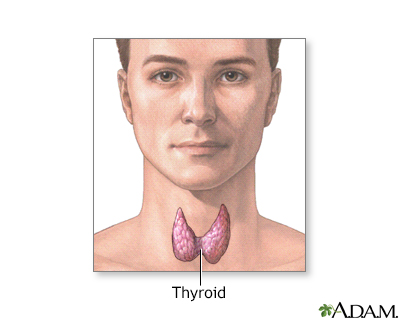Anaplastic thyroid cancer
Anaplastic thyroid carcinoma is a rare and aggressive form of cancer of the thyroid gland.
Causes
Anaplastic thyroid cancer is an invasive type of thyroid cancer that grows very rapidly. It occurs most often in people over age 60. It is more common in females than in males. The cause is unknown.
Thyroid cancer
Thyroid cancer is a cancer that starts in the thyroid gland. The thyroid gland is located inside the front of your lower neck.

Anaplastic cancer accounts for only about less than 1% of all thyroid cancers in the United States.
Symptoms
Symptoms include:
- Cough
- Coughing up blood
- Difficulty swallowing
- Hoarseness or changing voice
- Loud breathing
- Lower neck lump, which often grows quickly
- Pain in the neck
- Vocal cord paralysis
- Overactive thyroid (hyperthyroidism)
Hyperthyroidism
Hyperthyroidism is a condition in which the thyroid gland makes too much thyroid hormone. The condition is often called overactive thyroid.
 ImageRead Article Now Book Mark Article
ImageRead Article Now Book Mark Article
Exams and Tests
A physical exam almost always shows a growth in the neck region. Other exams may include:
- An MRI or CT scan of the neck may show a tumor growing from the thyroid gland.
MRI
A magnetic resonance imaging (MRI) scan is an imaging test that uses powerful magnets and radio waves to create pictures of the body. It does not us...
 ImageRead Article Now Book Mark Article
ImageRead Article Now Book Mark ArticleCT scan
A computed tomography (CT) scan is an imaging method that uses x-rays to create pictures of cross-sections of the body. Related tests include:Abdomin...
 ImageRead Article Now Book Mark Article
ImageRead Article Now Book Mark Article - A thyroid biopsy makes the diagnosis. The tumor tissue can be checked for genetic markers that may suggest targets for treatment, preferably within a clinical trial.
Biopsy
A biopsy is the removal of a small piece of tissue for laboratory examination.
Read Article Now Book Mark Article - An examination of the airway with a fiberoptic scope (laryngoscopy) may show a paralyzed vocal cord.
Laryngoscopy
Laryngoscopy is an exam of the back of your throat, including your voice box (larynx). Your voice box contains your vocal cords and allows you to sp...
Read Article Now Book Mark Article - A thyroid scan shows this growth to be "cold," meaning it does not absorb a radioactive substance.
Thyroid scan
A thyroid scan uses a radioactive iodine tracer to examine the structure and function of the thyroid gland. This test is often done together with a ...
 ImageRead Article Now Book Mark Article
ImageRead Article Now Book Mark Article
Thyroid function blood tests are normal in most cases.
Treatment
This type of cancer cannot be cured by surgery.
Surgery combined with radiation therapy and chemotherapy may have a significant benefit.
Surgery to place a tube in the throat to help with breathing (tracheostomy) or in the stomach to help with eating (gastrostomy) may be needed during treatment.
(tracheostomy
A tracheostomy is a surgical procedure to create an opening through the neck into the trachea (windpipe). A tube is most often placed through this o...

For some people, enrolling in a clinical trial of new thyroid cancer treatments based on the genetic changes in the tumor may be an option.
The presence of a mutation in the BRAF gene is treatable with targeted medicines and may improve outcomes.
Support Groups
You can often ease the stress of illness by joining a support group of people sharing common experiences and problems.
Outlook (Prognosis)
The outlook with this disease is poor. Most people do not survive longer than 6 months because the disease is aggressive and there is a lack of effective treatment options.
Possible Complications
Complications may include:
- Spread of tumor within the neck
- Metastasis (spread) of cancer to other body tissues or organs
Metastasis
Metastasis is the movement or spreading of cancer cells from one organ or tissue to another. Cancer cells usually spread through the blood or the ly...
 ImageRead Article Now Book Mark Article
ImageRead Article Now Book Mark Article
When to Contact a Medical Professional
Contact your health care provider if you notice:
- A persistent lump or mass in the neck
- Hoarseness or changes in your voice
- Cough or coughing up blood
Reviewed By
Todd Gersten, MD, Hematology/Oncology, Florida Cancer Specialists & Research Institute, Wellington, FL. Review provided by VeriMed Healthcare Network. Also reviewed by David C. Dugdale, MD, Medical Director, Brenda Conaway, Editorial Director, and the A.D.A.M. Editorial team.
Bible KC, Kebebew E, Brierley J, et al. 2021 American Thyroid Association guidelines for management of patients with anaplastic thyroid cancer. Thyroid. 2021;31(3):337-386. PMID: 33728999 pubmed.ncbi.nlm.nih.gov/33728999/.
National Cancer Institute. Anaplastic thyroid cancer (ATC). www.cancer.gov/pediatric-adult-rare-tumor/rare-tumors/rare-endocrine-tumor/anaplastic-thyroid-cancer. Updated February 27, 2019. Accessed May 3, 2024.
Pearce EN, Hollenberg AN. Thyroid. In: Goldman L, Cooney KA. Goldman-Cecil Medicine. 27th ed. Philadelphia, PA: Elsevier; 2024:chap 207.
Suh I, Sosa JA. Thyroid. In: Townsend CM Jr, Beauchamp RD, Evers BM, Mattox KL, eds. Sabiston Textbook of Surgery. 21st ed. St Louis, MO: Elsevier; 2022:chap 37.


 All rights reserved.
All rights reserved.